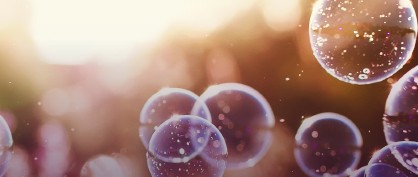Bubbles May Offer a New Pollination Method
By Kylie Wolfe
Bees are professional pollinators. They buzz from flower to flower like it’s their job, well, because it is. They play a critical role in crop production and are a vital part of our ecosystem.
But as you may have heard, populations are dwindling, so farmers are looking for new ways to replicate this important task. Some are even pollinating plants by hand.
In response, scientists from the Japan Advanced Institute of Science and Technology (JAIST) found a way to speed up this time-consuming and tedious process using pollen-containing bubbles. Their work was published in iScience.
Buzz-Worthy Workers
Many plants rely on bees and other insects for fertilization, transferring pollen from the anther, or male structure, to the stigma, or female structure. Doing so helps produce a variety of fruits, vegetables, and nuts.
While not all plants need insects for fertilization, many of the foods we enjoy require a little help from our friends in flight. Without their efforts, things like apples, avocados, coffee, and citrus fruits could be harder to come by.
A High-Tech Alternative
Eijiro Miyako, materials chemist at the JAIST, first attempted to replicate the pollination technique of bees with pollen-coated drones. Unfortunately, the drone propellers damaged the flowers.
To combat this, he and colleague Xi Yang, a JAIST environmental scientist, formulated a pollen-containing bubble solution. They found success with the chemical lauramidopropyl betaine, used in personal care products, combined with pollen-protecting ingredients, and a polymer to create a viable yet sturdy transport vessel.
Using this new method, the researchers released pollen-filled bubbles in the direction of three pear trees. Of the 50 pollinated blossoms on each tree, 95 percent of them formed fruit. This is comparable to the trees pollinated by hand. Not only did this approach require less effort, it required less pollen.
Pollinating by hand uses roughly 1800 milligrams of pollen per flower. Each bubble used only 0.06 milligrams. Because both processes also rely on humans to do the pollen harvesting, these savings could be important.
Miyako is currently working to pollinate larger areas by releasing the bubbles via drone, as well as make the solution more biocompatible.
Navigating Nature
Though the results are promising, the idea isn’t widely accepted as the answer to the pollination problem. Some fear the chemicals used to create the bubbles may interfere with the plants in the long term, while others are more concerned with the sustainability and overall effectiveness of the process. And some simply believe that protecting our natural pollinators should be the number one priority.
As scientists continue their quest to solve this looming issue, climate change, pesticides, and other factors threaten invaluable insects worldwide. The future of plant pollination could lie in bubble-blowing drones or it could be left to nature’s professionals — if there are enough of them to do the work.
Discussion Questions
- What are the pros and cons of automating the pollination process?
- What do you think is the best approach to ensure plant pollination in the future?
Vocabulary
- Anther
- Biocompatible
- Pollination
- Stigma


